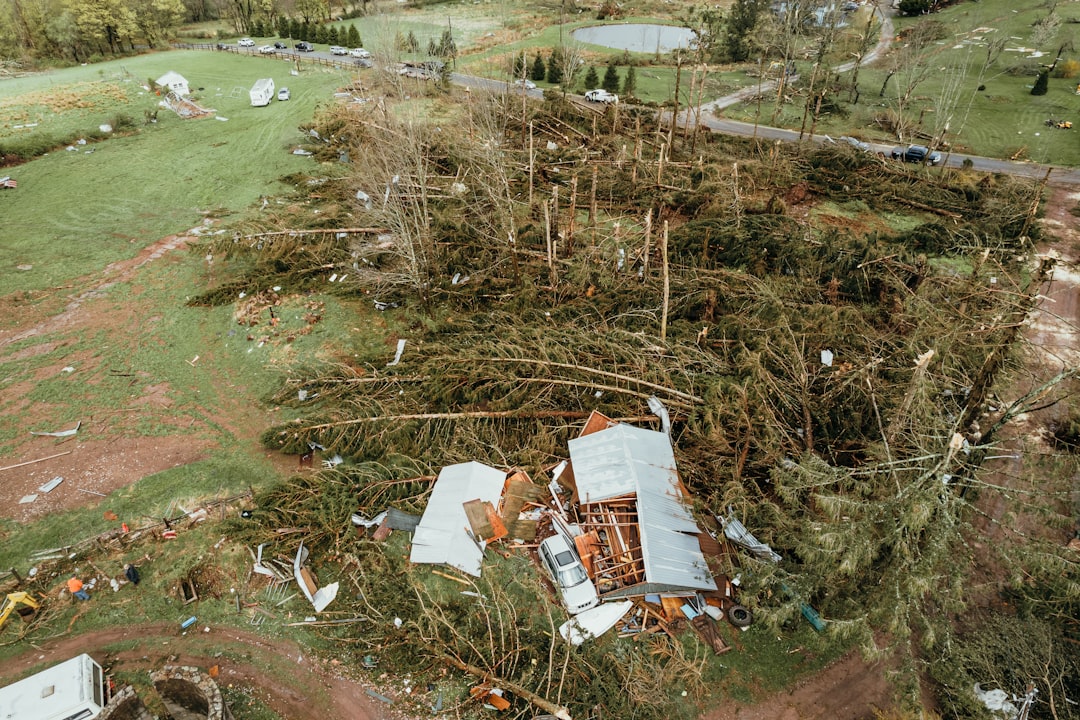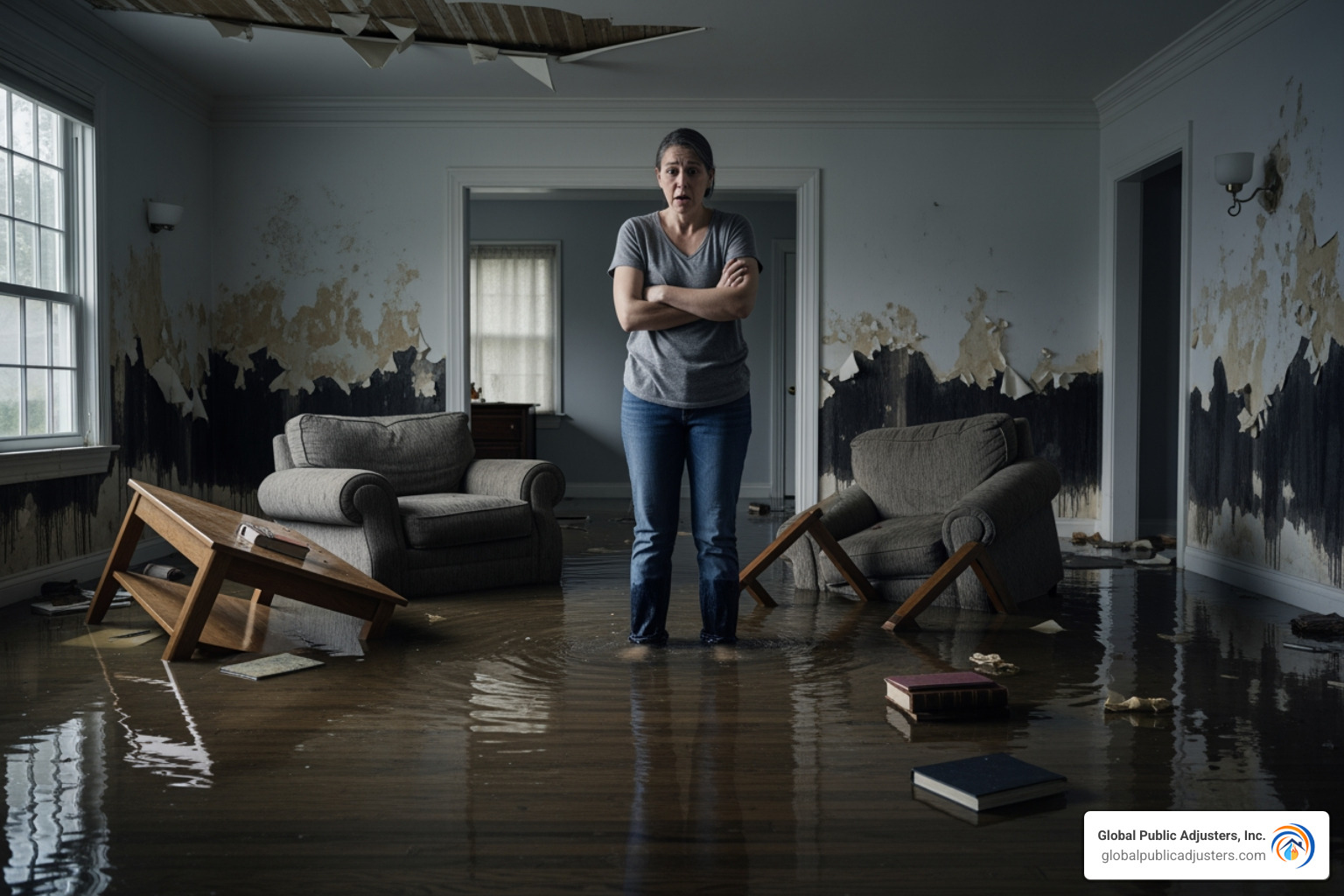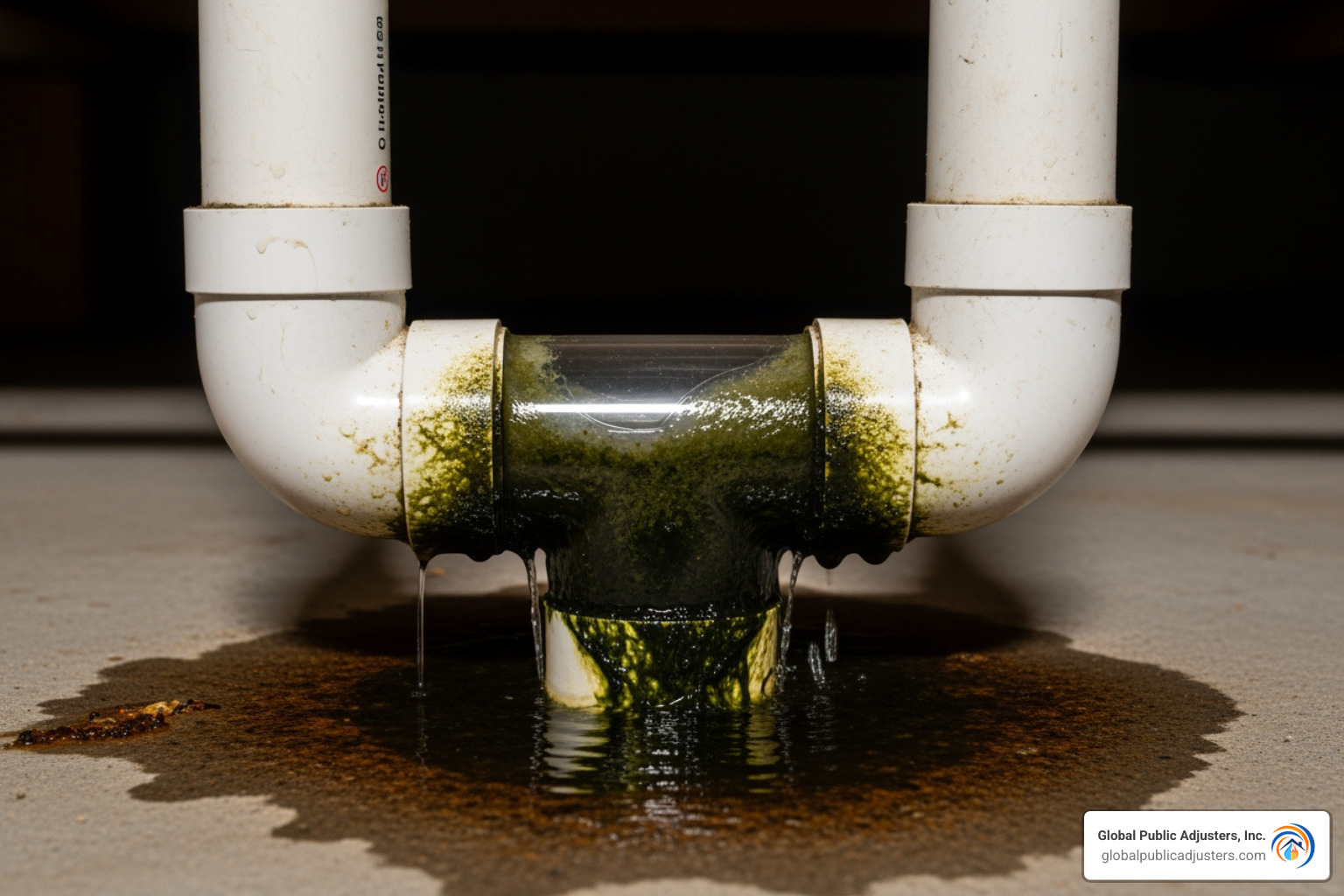Tornado Damage Claims: 5 Steps to Calm
Why Tornado Damage Claims Require Expert Navigation
Tornado damage claimsare overwhelming, especially amidst the stress of property damage and displacement. The good news is that most standard home insurance policies in Canada and the United States cover tornado damage under windstorm or hail coverage, but getting the full compensation you deserve requires knowing the right steps.
Quick Answer: Essential Steps for Tornado Damage Claims:
- Ensure Safety First– Check for gas leaks, downed power lines, and structural damage.
- Document Everything– Take photos and videos of all damage before cleanup.
- Contact Your Insurer Immediately– Report the claim within 24-48 hours when possible.
- Prevent Further Damage– Board windows, tarp roofs, and save all receipts.
- Work with Your Adjuster– Be present during inspections and ask detailed questions.
- Consider Professional Help– Public adjusters can maximize settlements for complex claims.
Canada is second globally for tornadoes, and in the U.S., they cause billions in annual property damage. Yet many property owners struggle with the complex claims process, often settling for less than they’re entitled to receive.
The path to recovery doesn’t have to be so difficult. This guide provides a step-by-step process for filing a successfultornado damage claim, from the first moments after the storm to the final settlement.
“No one can ever be prepared for damages tornadoes can bring,”but you can be prepared for what comes next. Whether you’re dealing with a damaged roof, destroyed personal property, or temporary displacement, understanding your rights and responsibilities makes all the difference in your recovery.
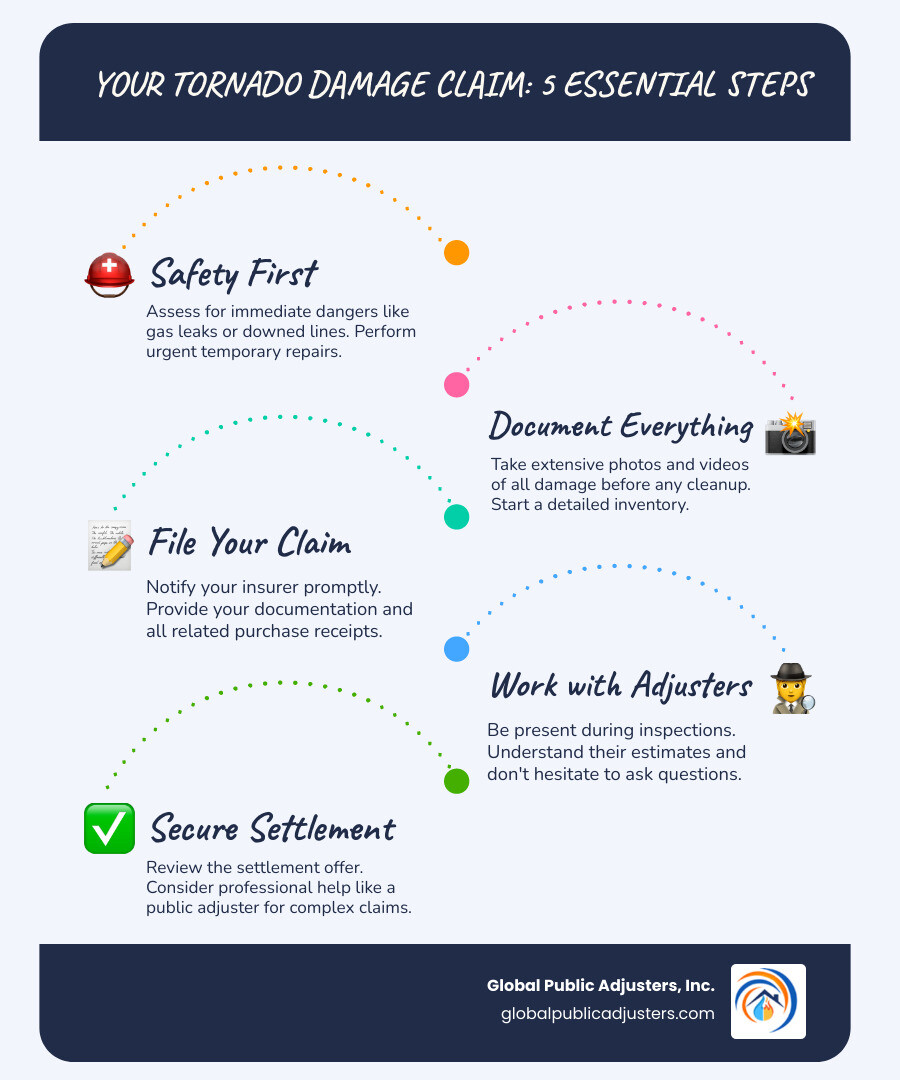
Immediate Aftermath: Safety and First Steps After a Tornado
After a tornado, the scene can be surreal. Before thinking about yourtornado damage claims, you must prioritize your family’s safety. A tornado is one of nature’s most destructive forces, common in areas like southern Ontario, Quebec, and the Prairies from March to October.
Prioritizing safetymeans checking yourself and others for injuries. Stay far away from downed power lines, which can be live and deadly. If you smell gas, evacuate immediately and call emergency services; don’t flip electrical switches if you suspect a leak or see water damage.
Your home’sstructural integrityis your next concern. Tornado winds can compromise foundations, walls, and roofing in ways that aren’t immediately obvious. If there’s significant damage, wait for professionals to give the all-clear before re-entering.
Once you’ve confirmed everyone’s safety,contact your familyand emergency contacts to let them know you’re okay.
Now comes a crucial step for your insurance claim:preventing further damage. Your policy includes a “duty to mitigate,” meaning you must take reasonable steps to stop additional damage. This doesn’t mean doing major repairs yourself, but taking sensible protective measures.
Temporary repairsmight include tarping a damaged roof, boarding up broken windows, or moving salvageable items away from leaks. Only do what you can safely accomplish. Keep every single receipt for materials you buy.
If you’re dealing with gas leaks, downed power lines, or severe structural damage,emergency servicesmust be your first call. Do not try to handle these situations yourself.
For comprehensive guidance on staying safe, we recommend youbrush up on safety tipsfrom official weather service sources.
What to Do Before the Adjuster Arrives
The time before your adjuster arrives is crucial for strengthening yourtornado damage claims, especially when widespread damage stretches adjusters thin.
Emergency repairsshould focus on preventing additional damage. Cover roof holes with tarps, board up broken windows, and move valuables to dry, secure areas. You’re not fixing everything, just stopping things from getting worse.
Boarding windowsandtarping roofsare common protective measures. Even a basic tarp secured with weights can prevent significant water damage.Save every receiptfrom this period—for tarps, plywood, batteries, and even bottled water. These expenses are often reimbursable.
Protecting undamaged propertyis also important. If one part of your house is damaged, take steps to prevent secondary issues like rain or mold from affecting the undamaged areas.
For more detailed guidance on handling residential damage, explore our comprehensiveResidential Damage Claim Guidance.
The work you do in these first hours and days sets the foundation for your entire claim process. Focus on safety and reasonable protection, and document everything.
Understanding Your Home Insurance Coverage for Tornado Damage
Reassuringly, most standard home insurance policies in Canada and the United States covertornado damage claims. This damage typically falls under “windstorm” or “hail” coverage. However, understanding your specific policy language is key to a smooth claims process and avoiding months of frustration.
Your home insurance policy is your financial safety net.Dwelling coverageprotects your home’s structure—roof, walls, and foundation—aiming to restore it to its pre-tornado condition.Personal property coverageprotects your belongings, from furniture and electronics to clothing and toys. Your policy also typically coversdetached structureslike a garage or shed.
An often-overlooked benefit isdebris removal coverage, which pays for removing unwanted debris like fallen trees from your property.
However, there are limitations.Flood damagefrom rising rivers or overland water flow is typically not covered; you need separate flood insurance for that. But if water enters your home through an opening created by the tornado (like a hole in the roof), that water damage is usually covered. Insurers also won’t cover damage from pre-existingwear and tear or lack of maintenance.
Key Coverage Types and What They Mean for Your Tornado Damage Claim
When a tornado makes your home unlivable,Additional Living Expenses (ALE)coverage becomes your lifeline. This coverage (also called Loss of Use) pays for necessary expenses while your home is being repaired.
ALE covershotel stays, excessmeal costs,relocation expenseslike temporary storage, and evenlaundry services. Keep every single receipt, as your insurer will require proof of these additional expenses.
Understanding how your belongings are valued is critical.Actual Cash Value (ACV)pays what your items were worth at the time of loss, including depreciation. A five-year-old TV might only get you a fraction of its original price.Replacement Cost Value (RCV)pays for brand-new replacements without deducting for age. RCV coverage costs more in premiums but provides far better protection.
For a deeper dive into how tornadoes can damage your property, check out our guide onCommon Types of Tornado Damage.
Comprehensive vs. Broad Coverage
The type of policy you have significantly impacts yourtornado damage claims. Understanding the difference helps you know what protection you have.
| Feature | Comprehensive (All-Perils) Coverage | Broad Coverage |
|---|---|---|
| What it covers | Covers damage to both the home (dwelling) and personal belongings from awide range of risks(all perils) unless specifically excluded. | Covers damage to the home (dwelling) fromall perilsunless specifically excluded, but covers personal belongings only fornamed perils(a specific list of risks). |
| Tornado Damage | Typically covers wind, hail, flying debris, and water entering through openings caused by the storm for both dwelling and contents. | Covers wind, hail, flying debris, and water entering through openings caused by the storm for the dwelling. For contents, it only covers if “windstorm” or “hail” is a named peril. |
| Common Exclusions | Earthquakes, floods, landslides, war, nuclear hazards, wear and tear, intentional damage. | Similar exclusions to comprehensive, plus potentially more limitations on personal property. |
| Cost | Generally higher premiums due to wider coverage. | Generally lower premiums than comprehensive. |
| Benefit | Offers the most protection and peace of mind, assuming a peril isn’t explicitly excluded. | Provides good protection for the dwelling but requires careful review of named perils for personal property. |
Comprehensive coverageprotects your home and belongings from everything unless a peril is specifically excluded.Broad coverageoffers the same protection for your home’s structure but only covers personal property for a list of named risks.
Review your policy with your insurance provider before you need it. Understanding your coverage now prevents surprises when filing atornado damage claim.
The Ultimate Checklist for Filing Successful Tornado Damage Claims
Filing atornado damage claimis a methodical process. Following the right steps from the beginning will help you get the results you need.
Contact your insurer immediatelyonce it’s safe. Delays can complicate your claim, as some policies have strict deadlines. Get aclaim numberand your adjuster’s contact information, and keep it handy.
The golden rule oftornado damage claimsis todocument everything before you clean up. Resist the urge to start clearing debris immediately. Your damaged property is evidence; once it’s gone, it’s gone forever.
Photo and video evidenceare your best friends. Use your smartphone to capture the scene from every angle. Take wide shots to show the overall damage, then zoom in on specific problems. Photograph damaged ceilings, walls, floors, and belongings in every room, including the attic and basement if they are safely accessible.
Video walkthroughsare incredibly powerful. Start at your front door and narrate what you see as you walk through the property, such as, “Here’s where the tree came through the living room window,” or “You can see water damage on the ceiling from the roof being torn off.”
Next is the crucial task ofcreating a detailed home inventory. Document every damaged or destroyed item. Start with big-ticket items like furniture and appliances, then move to smaller belongings. The more thorough you are, the smoother your claim will be.
Gathering proof of purchasecan be tough if records were destroyed. Receipts are ideal, but you can also use email confirmations, credit card statements, or even social media photos showing the items in your home.
Getting repair estimatesfrom reputable contractors provides valuable leverage. While your insurer will have its own adjuster, having two to three independent estimates for major work shows you’ve done your homework.
How to Document Damage for Your Tornado Damage Claim
Creating a comprehensive damage inventory is like gathering evidence for a case. The more organized your documentation, the stronger yourtornado damage claimwill be. Your goal is to paint a complete picture of your losses.
For each damaged item, include the following details:
- Item Description:Be specific (e.g., “Sony 55-inch 4K Smart TV,” not just “TV”).
- Purchase Date & Original Cost:Estimate if you don’t have receipts. Insurance companies understand you may not have exact figures.
- Estimated Replacement Cost:Research current prices online for comparable new items.
- Model & Serial Numbers:Crucial for electronics and appliances. Look for them on stickers or plates on the back or bottom of devices.
- Condition Before Tornado:Be honest (e.g., brand new, gently used, or showing age). This builds trust with your adjuster.
- Extent of Damage:Describe the damage in detail (e.g., “screen shattered by flying debris” or “crushed by falling tree branch”).
- Photo/Video Reference:Link your written inventory to your visual evidence to create a clear paper trail.
Keep all damaged items until your adjuster has inspected them, even if they seem like total losses. That waterlogged mattress is evidence supporting your claim. For additional guidance, ourProperty Damage Claims Guidanceprovides valuable insights for navigating the claims process.
Navigating the Process: Working with Adjusters and Contractors
After filing yourtornado damage claims, you’ll enter the challenging phase of working with insurance adjusters and contractors. Knowing the steps can make all the difference.
Your insurance adjuster is crucial to your claim, but remember:they work for the insurance company, not you. While most are fair professionals, their primary duty is to their employer. This means you must be your own best advocate.
Effective communication is key.Keep a written record of all conversations, preferably via email. Follow up phone calls with a summary email to create a paper trail, which can be invaluable if disputes arise.
When dealing with adjusters,be polite but firm. They are often overwhelmed after major storms, but don’t let politeness stop you from being assertive about your rights and the full extent of your damages.
Understanding your adjuster’s estimate is critical. Don’t just look at the total; review the details. Ask how they calculated values and repair costs. Pay close attention to“overhead and profit”(often called “10 & 10”). Some insurers try to exclude this legitimate cost, but if your damage involves multiple trades, a general contractor’s overhead and profit are necessary expenses.
Finding trustworthy contractors after a tornado requires caution, as disaster areas attract scammers.Never work with door-to-door contractorswho appear uninvited. Instead, get multiple quotes from licensed, insured contractors and ask for proof of liability and workers’ compensation coverage. Check references and online reviews.
For roofing work specifically, you can find reputable contractors through resources like the North/East Roofing Contractors Association Member Directory. Most importantly,never pay cash upfrontor sign your insurance settlement directly over to a contractor. Collect your settlement first, then pay your contractors.
Dealing with Your Insurance Adjuster
Your interaction with the insurance adjuster can determine the success of yourtornado damage claims. This meeting is your chance to ensure nothing is overlooked.
Always be present during the adjuster’s inspection. Walk through every damaged area with them, pointing out all the damage you’ve documented. Don’t assume they’ll notice everything. Bring your photos and documentation to reference during the walkthrough.
Ask lots of questions.Find out how they plan to calculate repair costs and when you can expect payment. If something in their estimate doesn’t make sense, keep asking for clarification.
When the adjuster’s estimate seems too low,don’t accept it immediately. Present your contractor estimates and documentation to support your position. The first estimate is often a starting point for negotiation.
If your policy pays Actual Cash Value,depreciation will reduce your payout. Understand how this was calculated, especially for newer items, and know that you have the right to negotiate these figures.
If you strongly disagree with the adjuster’s assessment, consider getting a second opinion. A public adjuster can provide an independent evaluation and help ensure fair treatment. Learn more aboutWhat Can a Public Adjuster Do For Me?to see how professional advocacy can level the playing field.
When to Call for Backup: Seeking Professional Help for Your Claim
Sometimes, a situation is too big to handle alone.Tornado damage claimscan be one of those moments. While many homeowners manage straightforward claims, bringing in a professional is often the smartest move.
You wouldn’t represent yourself in a complex legal case, so why handle a high-stakestornado damage claimalone, especially when your family’s financial security is on the line?
Consider hiring a public adjuster in these situations:
- Complex Claims:Damage to multiple systems (roofing, electrical, structural) requires an expert eye to uncover hidden issues that others might miss.
- High-Value Losses:When the stakes are high, professional negotiation skills can make a significant difference in your final settlement.
- Underpaid Settlements:If an initial offer is too low, a public adjuster can re-evaluate your damage and negotiate for the compensation you actually deserve.
- Claim Denials:A professional can review the denial, challenge it with solid evidence, and often reopen negotiations successfully.
- Bad Faith Tactics:If your insurer uses unreasonable delays or misrepresents your policy, a public adjuster provides persistent, professional advocacy to resolve the issue.
A public adjuster works solely for you, the policyholder. We interpret your policy, document your losses, and negotiate with your insurance company to maximize your settlement. At Global Public Adjusters, Inc., our 50+ years of experience in Orlando, Pensacola, and across Florida means we know how to counter insurer tactics effectively.
The insurance company has a team of experts working for them. Shouldn’t you have someone in your corner too?
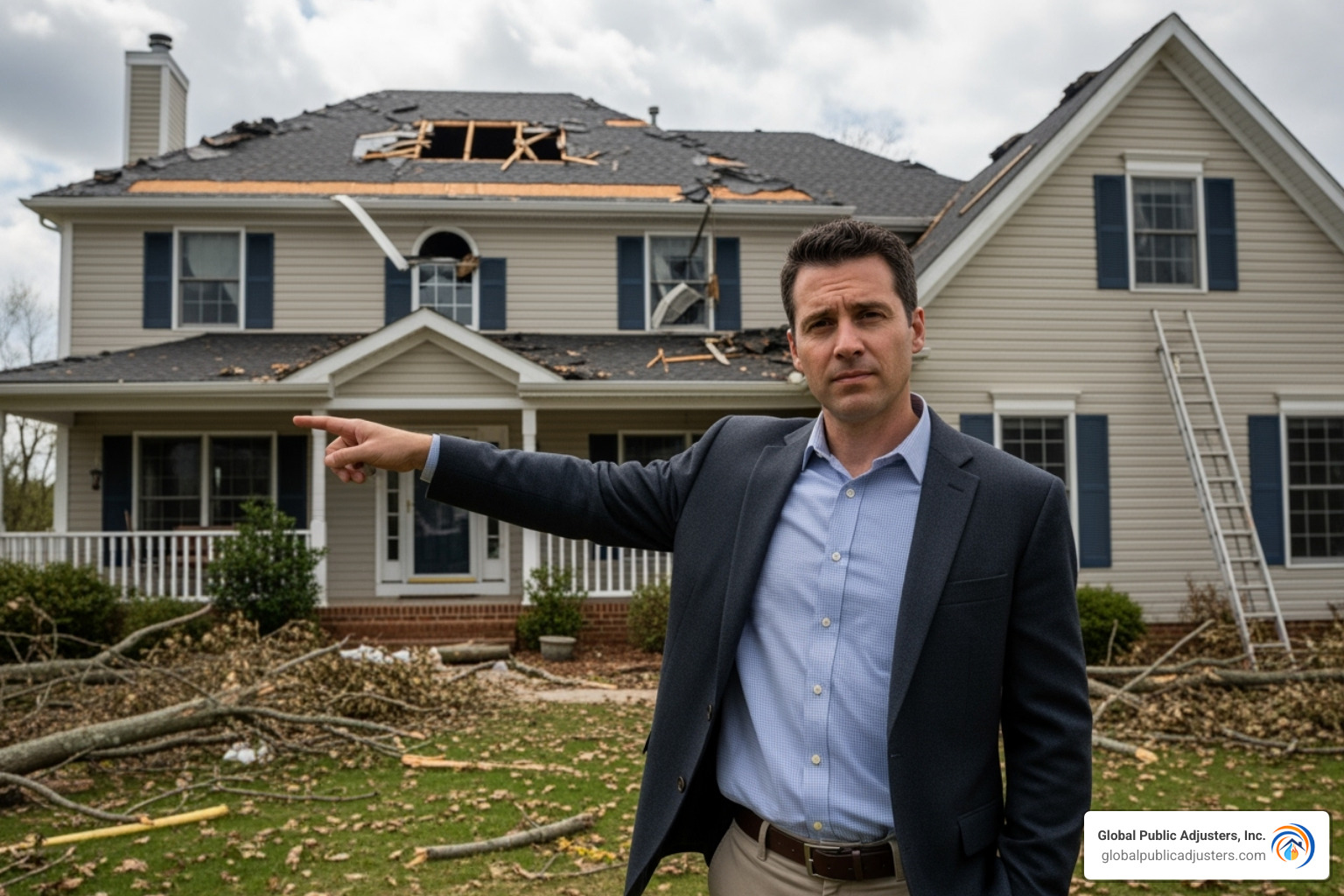
Signs You Need a Public Adjuster for Your Tornado Damage Claim
It’s normal to feel overwhelmed after a tornado. You’re suddenly expected to be an expert in insurance, construction, and damage assessment while managing your displaced family. If any of these situations sound familiar, it might be time to call for backup.
- You feel overwhelmed.The sheer volume of tasks after a tornado is staggering. A public adjuster handles the paperwork, phone calls, and negotiations so you can focus on your family.
- Lack of communication from your insurer.If your calls go unreturned or you feel you’re getting the runaround, professional representation can change the dynamic. Insurers often respond more seriously to an expert advocate.
- Disagreement over the scope of damage.If the adjuster’s assessment seems to minimize the damage, a public adjuster can provide an independent, thorough evaluation that documents the true extent of your loss.
- Insufficient settlement offers.When a settlement check won’t cover the cost of repairs, something is wrong. Public adjusters use current pricing data and negotiation skills to push for settlements that reflect the true cost of restoration.
Studies consistently show that policyholders with public adjuster representation tend to collect significantly more than those who go it alone. We don’t just level the playing field—we tilt it in your favor.
Working with Global Public Adjusters, Inc. can transform your claim from a nightmare into a manageable process. Want to learn more? Check outWhy Hire a Public Adjuster for Property Damage?and exploreThe Top Four Reasons to Hire a Public Insurance Adjuster Now.
Conclusion
Navigatingtornado damage claimsis challenging, but manageable. This guide has covered the key steps: ensuring safety, understanding your policy, documenting damage, and working with adjusters.
The most important thing to remember is that knowledge is your best defense against an unfair settlement. When you understand your policy, document everything, and know what to ask, you’re already ahead.
But you don’t have to handle it alone. If you’re overwhelmed by juggling repairs and family life, or if the adjuster’s estimate seems way off, professional help can make all the difference.
At Global Public Adjusters, Inc., we’ve spent over 50 years helping property owners steer complex insurance claims. We’ve seen every trick insurers use, and we know how to counter them. We understand that behind every claim is a real person trying to rebuild their life.
Yourtornado damage claimis about getting your life back on track. Whether it’s ensuring your family has a safe home or helping your business reopen, we are committed to fighting for every dollar you deserve.
The path to recovery starts now. Don’t let the insurance company dictate the terms. You’ve survived the storm—let us help you steer what comes next.
Ready to get the settlement you deserve?Get professional help with your Tornado Damage Claimsand let our experience work for you. After everything you’ve been through, you deserve an advocate who is truly on your side.


